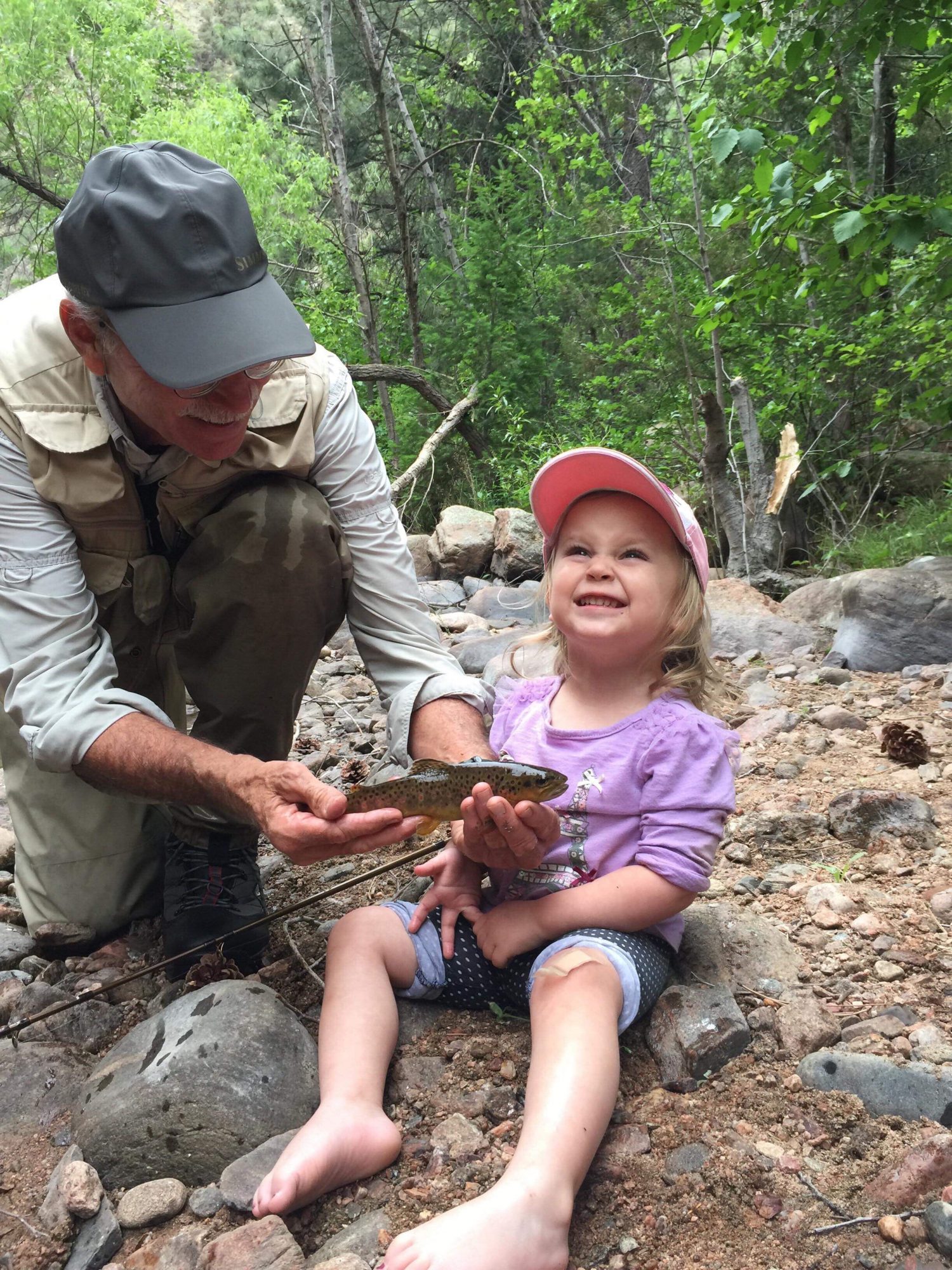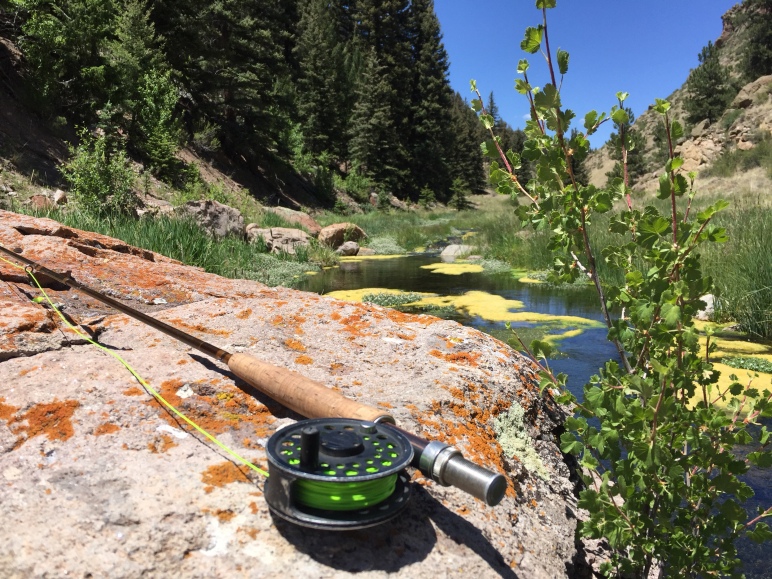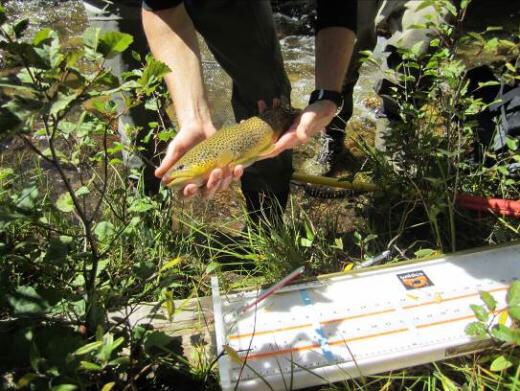A friend once made the heartening observation—
“It is always easy to say something nice about fishing.” Charles Goodspeed
June 2018
Note: For Act One and other outings on Badger Creek, see my October and December 2017 articles about fall fishing on Badger Creek.
https://hooknfly.com/2017/12/05/badger-creek-legend-of-the-late-fall-1-near-salida-co/amp/
Late last fall I explored the upper reaches of Badger Creek just off the Ute Trail in Gribbles Park, about an hour’s drive from Salida. I had an interesting day boulder hopping downstream for about a mile to where the little rivulet Steer Creek gurgles down the hillside into Badger. I fished back upstream through a series of beautiful pools and caught a couple of dozen brownies, a few going 13 inches. Now I’m back aiming to explore the second mile of the creek as it continues its journey through a scenic canyon to join the Arkansas River 15 miles downstream.
I’m on the road early at 7 a.m., the forecast for more dry, sunny and warm weather. I’m kicking up dust clouds on Chaffee County Road 175/82 and then the Ute Trail (Fremont County Road 2), reflecting the serious drought gripping the region. I haven’t been able to check the water level on Badger Creek since there is no state or federal flow gauges, so I have more than a little trepidation that there may not be enough water to float a trout.
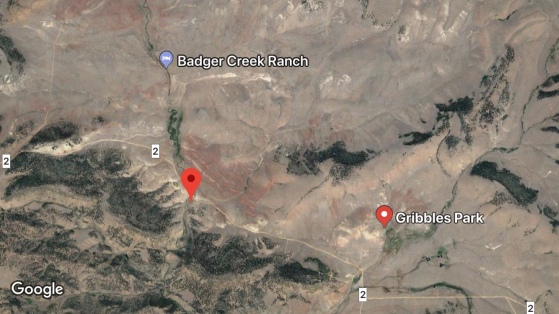
The drive is as scenic as I remembered it, and the first view of Gribbles Park where Badger Creek arises, is a stunner, a quintessential western landscape with a broad valley, ridges, and peaks in the distance.

The Badger Creek basin is chock full of history. The Utes hunted here as witnessed by the discovery of a buffalo jump, a cliff formation used by the Utes to drive herds en masse to their death. One of the nearby peaks is reputed to be where they held vision quests. Ira Mulock rode into the valley in 1870s with a herd of cattle up from Texas and started the historic IM Ranch, one of the first mountain spreads in this part of Colorado. Tales of range wars over grass and water followed. Today it is operated as Badger Creek Ranch, a working cattle/dude ranch. Lon and Badger Gribble were two other prominent early ranchers, leaving their names on the valley and the creek itself.
My first glimpse of the creek as it parallels the Ute Trail is not encouraging. It never runs heavy, except after a big rain, but it’s hardly a trickle, and the flow is a sickly cloudy green. I cross over the creek and take a right off of the Ute Trail into a sizable parking area on BLM land.
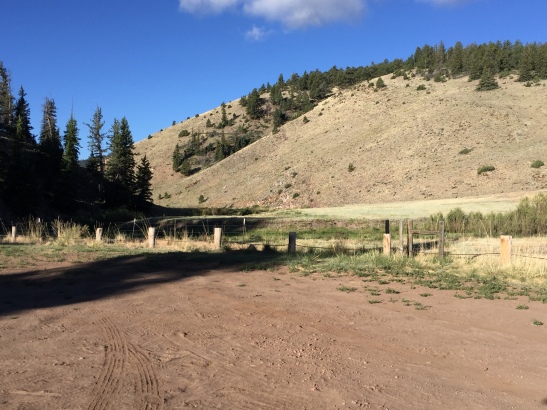
It’s taken me over an hour to make the drive so I’m anxious to get on the trail. I could probably wet wade, but knowing there are some deep pools, I decide to pull on my lightweight chest waders and new Simms Vapor boots, the best designed wading/hiking boots I’ve ever owned—very comfortable if you intend to take a long walk in to a stream as I often do. I navigate through the sturdy fence in the designated spot, then catch my first glimpse of the creek. While I was prepared for low water, my jaw still drops. A toddler could jump over the creek.

But I know things will get better only a quarter mile or so downstream where at the bottom of a cliff the Big Springs kick in. Sure enough, as I round the first bend and walk into the meadow, I see flotillas of vegetation around the mouth of the spring and hear a little bit of a roar. Hallelujah. There’s even more water than last fall—I estimate the creek is running somewhere between 15 and 20 cfs, plenty of water, and it’s cold and clear.
As I follow the trail on the north side of the creek up and down over a couple of ridges, I vow not to stop and sample the pools below that produced some good trout last fall. I have a lot of ground to cover—over two miles–down to Gribbles Run meadow. I am already huffing and puffing, as the creek takes a hard turn to the south, and the trail descends to a stream crossing at the edge of a boulder field.

This calls for my best mountain goat imitation to scale the rocks on the other bank. Caveat: Make sure you bring a hiking or wading staff—you’ll be glad you did, especially for the hike down to Steer Creek.
I’m a little winded now, and losing my resolve, decide to take a short break and sample one of the tempting pools upstream of Steer Creek. Glad I did. As my #16 Royal Coachman Trude bobs jauntily down through a good-looking pool, it suddenly disappears, and I am onto a nice brownie that ate the #18 green hotwire CDC caddis nymph, one of my own creations. Great start!
I manage to catch another smaller one before I hang up my dropper in some of the tall, lush streamside grass. And it won’t let go no matter what I do. The grass will plague me all day when I fail to watch my backcast carefully on this narrow little stream.
I continue downstream and then cross back to the west side of Badger and step over little bubbling Steer Creek. My resolve is again tested as I continue downstream and wade past a couple of enticing, deep emerald-green pools where I can see dozens of fish finning, finally emerging into what I call Ponderosa Park. Here the canyon walls start to recede a bit, and the creek starts to change character, more of a meadow water with shallow, fast glassy runs and fewer boulders and plunge pools than above. This is a great spot for lunch, so I stow my little cooler under a beautiful spruce tree in the middle of the park that provides shade and seclusion.

Of course I have to sample the creek again, and quickly catch a couple of small, energetic brownies in a straight shallow run, one taking the dry and the other the nymph.
It’s here that I start to notice a lot more aquatic vegetation including the infamous Badger Creek Yellow-Green Blobs. These mats of moss and goo reportedly take over the creek by late summer. Today they are a minor annoyance, sometimes eating my fly at the end of a drift.
I continue down the trail until it emerges into a broad meadow where Gribbles Run cuts in from the east. Of course it’s bone dry. Badger Creek is dramatically different here. It’s flowing clean and clear, but is more like an eastern spring creek, filled with rafts of floating and submerged vegetation waving in the current, with narrow slots of open water in between.
I step into the creek below a little riffle and several nice trout shoot out from under the rafts as well as the undercut banks. Yikes, this is going to be a challenge. A fish is rising at the top of the pool, so I loft a cast into the swirl, and immediately hook a nice trout that proceeds to dive into the vegetative sanctuary. When I finally work my way up to my fly, of course the fish has twisted off. The next pool results in my nymph dredging one of the green blobs. As does the next, coating my hook with riverbed detritus. Fish are rising, indeed jumping out of the water, but ignoring my Trude. Then I see the proverbial sign from above—a hazy cloud of little black Trico mayflies hovering upstream over the next pool. I can tell there is going to have to be an attitude and fly readjustment at this point.

I tie on a new rig that has worked well on similar waters like Archuleta Creek, a spring-creek like tributary of Cochetopa Creek near Gunnison, Colorado (See my August 2016 article.). I tie on a little #20 foam parachute midge that imitates the Tricos trailed 18-inches below by a #18 red zebra midge.

I usually tie my droppers 30-inches below the dry I’m using, but shorten it here to avoid snagging the nymph on shoreline grass when trying to place the dry next to the bank. Also, the shorter dropper means it is less likely to get caught up in the submerged stream vegetation. The midge is virtually invisible to the eye on the water, so I tie on a small piece of yellow yarn as a strike indicator about three feet above the dry. I then sneak up slowly on the next pool where a couple of trout are rising.
My first cast alights delicately in the streamside grass, a full five feet from my intended target. But by the grace of the angling gods, it does not snag and somehow manages to end up in the creek when I give it a prayerful jerk. And WHAM! A nice 13-inch brownie cannot resist the dry, and as he cavorts about one of his buddies nails the nymph. A double!! I have cracked the code!!
The small dry does not spook the fish in the shallower, crystal clear water, and the tiny zebra midge doesn’t sink as fast as the bigger caddis nymph and thereby avoids getting swallowed up on the submerged vegetation—or at least not as often. For the next couple of hours I have a blast catching eager brownies in every run and every pool. Most only go 6-11 inches, but a few healthy 12-13 inchers come to the net.

As with most small canyon creeks, stealth is still a key. I do my best to kneel when casting in the creek or get out of the water and cast from the shore where possible. I still spook a lot of fish—the number of trout in this little creek is astounding, and I see and scare a couple of lunkers that would go 15-inches.
By the time I reach my lunch cooler in Ponderosa Park at 2:30 p.m., I am famished and in need of a good rest. As I age, I force myself to take 30 minutes for lunch versus the ten minutes allotted in my foolish youth. Sitting in the shade under the giant spruce, I reflect on how Badger Creek went from a basket case in the 1980s to a beautiful, well-managed water it is today full of well-fed fish. The great recovery started, as is often the case, after a catastrophic natural disaster. A major rainstorm hit the area in 1979 and as a result of overgrazing and poor conservation management on both public and private lands upstream, unleashed a tremendous flood. The flow in the canyon was estimated at 10,000 CFS—that’s five times the flow the mighty Arkansas River carries during spring runoff. The canyon was scoured and tons of sediment deposited downstream. In the wake of the flood, federal land managers got together with state officials and local ranchers and worked on a landmark cooperative restoration plan. Ranchers were offered incentives in the form of cost sharing to fence off significant stretches of the creek from cattle that can trample a streambank into oblivion in a flash. Ranchers also agreed to rotate their herds to reduce overgrazing, and shorelines were repaired with plantings. The results can be seen today. Badger Creek below the Ute Trail has come roaring back! Not surprisingly, the creek is becoming better known among angling aficionados, but the farther I hiked down the canyon, the fewer boot marks I see and don’t run into any living soul all day!
After downing one last swig of my elixir, a can of venerable RC Cola, I hit the creek again. It’s getting late, the sun starting to sink behind the cliffs to the west–but I still have those big deep pools just above Ponderosa Park to sample, and I won’t go home until I do. I mosey down to the creek and am treated to one of those unexpected delights of nature that turn a good day into a memorable–a flight of blue darners, one of my favorite dragonflies, is holding a love-in! What a sight!!
I finally tear myself away from the love bugs and proceed upstream. I catch several good ones in the first deep pool below a little waterfall. I proceed to work up to the waterfall where the water is over my waist, and peer into the pool above. Trout are rising steadily. I have to execute a tricky backhand cast upstream around a boulder to land the fly in the current, but when I do succeed every time a good trout blasts either the dry or nymph. Six trout come out of that beautiful little pool.

Then further upstream I arrive at the honey hole that I had crossed just below Steer Creek earlier in the day. I can see over a dozen smaller fish finning nonchalantly in the shallows below a pool so deep I can’t see the bottom. I decide to cast over the little guys, hoping I don’t send them fleeing to tattle on me to the bigger ones above. The flies land in the riffle at the head of the pool, and the faux Trico swirls into the deeper water, then bounces against big boulder that deflects the current. I watch, mesmerized by the picture-perfect scene, then notice the strike indicator is gone! I set the hook and feel a good trout shaking his head in the depths. He slashes back and forth in the pool, giving me time to grab my cell phone from my vest and shoot a video of the fight. He’s a game one and puts on a good show. One of the biggest of the day!
Now I vow in earnest that he will be the last one. I have a good half-hour uphill hike in front of me to get back to the SUV and then another hour drive to my cabin in Salida, so need to rock and roll. But dang, only 10 minutes into the return hike, I spot a pool I fished successfully last fall that has fish dimpling the surface everywhere. I lecture myself that this will absolutely be the last cast (if I get a fish). And I do. I wait for a good one to rise, let him settle for a bit, then lay my fly a few feet above where he had shown himself. And right on cue, the beauty surfaces and gulps in the midge dry. After a good tussle, the big brownie comes to the net for a quick photo and release.
I am smiling broadly—always a good feeling to catch a good fish on that last cast of the day. I tip my hat to Badger Creek as I hustle back to the parking lot and scoot back to Salida. Act Deux on Badger Creek has been a good one. I can’t quibble with what goes on in Gribbles.


Note: For information about accommodations and fishing at nearby Badger Creek Ranch, call 719-837-2962.
